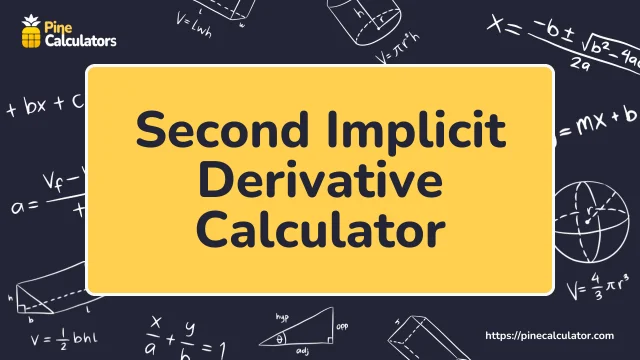Introduction to Second Implicit Derivative Calculator:
The second implicit derivative calculator is an online tool that helps you to find the second derivative of an implicit function. It is used to evaluate the function which becomes explicitly a function of y with respect to variable x.

It is an education tool that helps students and teachers or professionals who want to learn the basic understanding about first-order implicit function derivatives with second order implicit functions even if you have complex derivative implicit function problems.
What is the Second Implicit Derivative?
A second implicit derivative is defined as a method for finding the second-order differentiation of the first-order implicit function differentiation. When you take the implicit function's first-order differentiation, it becomes an explicit function. This means you take the second derivative of the explicit function only.
It refers to the second derivative of a function y that is implicitly in terms of another variable x. When a function is defined implicitly, the relationship between x and y is given as:
$$ F(x,y) \;=\; 0 $$
Where, F is some function involving x and y.
How to do Implicit Differentiation Second Derivative?
If you need to find the second derivative of an implicit function, you can use our fast and accurate second implicit derivative calculator. For manual calculations, you should differentiate with respect to x while treating y as a function of x. Here are the calculation steps of implicit differentiation for the second derivation function.
Step 1: First take the differentiate of a given equation on both sides with respect to x.
Step 2: After that use the algebraic method to simplify the differential function.
Step 3: Again differentiate the above function with respect to x and keep y as a constant.
Step 4: Simplify the function using algebraic function to get the solution of the second implicit differentiation function.
Step 5: It will make sure y term is separated from the x term in such a way it writes on one side of the equation and x term on the other side as a result.
Practical Example of Second Implicit Differentiation:
The example of second implicit differentiation with solution gives you a better understanding about the calculation process of the d2y/dx2 calculator.
Example:
Find the following if x2+y2 = 25.
$$ \frac{d^2 y}{dx^2} $$
Solution:
Differentiate the given function with respect to x,
$$ \frac{d}{dx}(x^2 + y^2) \;=\; \frac{d}{dx}(25) $$
After derivation simplify the above expression,
$$ \frac{d}{dx}(x^2) + \frac{d}{dx}(y^2) \;=\; 0 $$
$$ 2x + 2y \frac{dy}{dx} \;=\; 0 $$
$$ 2y \frac{dy}{dx} \;=\; -2x $$
$$ \frac{dy}{dx} \;=\; - \frac{x}{y} $$
Differentiate the first derivative again with respect to x,
$$ \frac{d^2 y}{dx^2} \;=\; \frac{d}{dx} \left(-\frac{x}{y} \right) $$
Use the quotient rule to solve it,
$$ =\; -\frac{\left( 1 . y - x \frac{dy}{dx} \right)}{y^2} $$
$$ =\; \frac{-y + x \frac{dy}{dx}}{y^2} $$
$$ =\; \frac{-y + x \left(-\frac{x}{y} \right)}{y^2} $$
$$ =\; \frac{-y^2 - x^2}{y^3} $$
The result of second implicit function derivation is,
$$ =\; \frac{-y^2 - x^2}{y^3} $$
How to Use the Second Derivative Implicit Differentiation Calculator?
The implicit differentiation second derivative calculator has an easy-to-use interface, so you can easily use it to evaluate the second derivative of implicit questions. Before adding the input for the solutions of the second implicit problem, you must follow some simple steps for the calculation process. These steps are:
- Enter the derivative function for the second implicit function in the input box.
- Review your input function of the second derivative of the implicit function before hitting the calculate button to start the calculation process.
- Click on the “Calculate” button to get the desired result of your given second derivative of implicit function problem.
- If you want to try out our implicit second derivative calculator to check its accuracy in solution then use the sample example first.
- Click on the “Recalculate” button to get a new page for solving more second implicit derivative questions.
Outcome from the Second Derivative Calculator Implicit:
The double implicit differentiation calculator gives you the solution to a given problem when you add the input to it. It may included:
- Result Option:
You can click on the result option and it provides you with a solution for second implicit derivative questions.
- Possible Step:
When you click on the possible steps option it provides you with the solution of the second implicit problem where all calculation steps present in detail.
Useful Features of the Second Implicit Derivative Calculator:
The d2y/dx2 calculator has useful features whenever you use it to calculate implicit problems of second order to get its solution immediately. These features are:
- Our second derivative implicit differentiation calculator saves the time and effort that you consume in solving complex implicit function questions in a few seconds.
- It is a free-of-cost tool that provides you with a solution to a given second implicit derivative problem without paying a single penny.
- It is an adaptive tool that allows you to find precise solutions from the given second implicit derivative function in the implicit differentiation second derivative calculator .
- You can use this tool for practice so that you get a strong hold on this concept.
- Implicit second derivative calculator is a trustworthy tool that provides you with accurate solutions as per your input to calculate the second implicit function problem.










